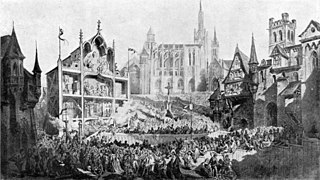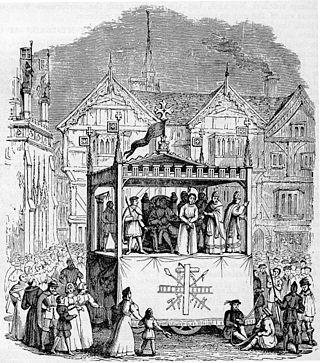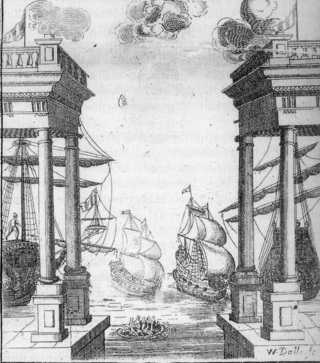Related Research Articles

Mystery plays and miracle plays are among the earliest formally developed plays in medieval Europe. Medieval mystery plays focused on the representation of Bible stories in churches as tableaux with accompanying antiphonal song. They told of subjects such as the Creation, Adam and Eve, the murder of Abel, and the Last Judgment. Often they were performed together in cycles which could last for days. The name derives from mystery used in its sense of miracle, but an occasionally quoted derivation is from ministerium, meaning craft, and so the 'mysteries' or plays performed by the craft guilds.

A theatre director or stage director is a professional in the theatre field who oversees and orchestrates the mounting of a theatre production such as a play, opera, dance, drama, musical theatre performance, etc. by unifying various endeavors and aspects of production. The director's function is to ensure the quality and completeness of theatre production and to lead the members of the creative team into realizing their artistic vision for it. The director thereby collaborates with a team of creative individuals and other staff to coordinate research and work on all the aspects of the production which includes the Technical and the Performance aspects. The technical aspects include: stagecraft, costume design, theatrical properties (props), lighting design, set design, and sound design for the production. The performance aspects include: acting, dance, orchestra, chants, and stage combat.

The Passion Play or Easter pageant is a dramatic presentation depicting the Passion of Jesus Christ: his trial, suffering and death. The viewing of and participation in Passion Plays is a traditional part of Lent in several Christian denominations, particularly in the Catholic and Evangelical traditions; as such Passion Plays are often ecumenical Christian productions.

Stagecraft is a technical aspect of theatrical, film, and video production. It includes constructing and rigging scenery; hanging and focusing of lighting; design and procurement of costumes; make-up; stage management; audio engineering; and procurement of props. Stagecraft is distinct from the wider umbrella term of scenography. Considered a technical rather than an artistic field, it is primarily the practical implementation of a scenic designer's artistic vision.

A wagon or waggon is a heavy four-wheeled vehicle pulled by draught animals or on occasion by humans, used for transporting goods, commodities, agricultural materials, supplies and sometimes people.

A tableau vivant, French for 'living picture', is a static scene containing one or more actors or models. They are stationary and silent, usually in costume, carefully posed, with props and/or scenery, and may be theatrically lit. It thus combines aspects of theatre and the visual arts.

General Idea was a collective of three Canadian artists, Felix Partz, Jorge Zontal and AA Bronson, who were active from 1967 to 1994. As pioneers of early conceptual and media-based art, their collaboration became a model for artist-initiated activities and continues to be a prominent influence on subsequent generations of artists.

The Chester Mystery Plays is a cycle of mystery plays originating in the city of Chester, England and dating back to at least the early part of the 15th century.

The Restoration spectacular was a type of theatre production of the late 17th-century Restoration period, defined by the amount of money, time, sets, and performers it required to be produced. Productions attracted audiences with elaborate action, acrobatics, dance, costume, scenery, illusionistic painting, trapdoors, and fireworks. Although they were popular with contemporary audiences, spectaculars have earned a reputation from theatre historians as vulgar in contrast to the witty Restoration drama.
A revolving stage is a mechanically controlled platform within a theatre that can be rotated in order to speed up the changing of a scene within a show. A fully revolving set was an innovation constructed by the hydraulics engineer Tommaso Francini for an elaborately produced pageant, Le ballet de la délivrance de Renaud, which was presented for Marie de Medici in January 1617 at the Palais du Louvre and noted with admiration by contemporaries. Such a stage is also commonly referred to as a turntable.

Medieval theatre encompasses theatrical performance in the period between the fall of the Western Roman Empire in the 5th century and the beginning of the Renaissance in approximately the 15th century. The category of "medieval theatre" is vast, covering dramatic performance in Europe over a thousand-year period. A broad spectrum of genres needs to be considered, including mystery plays, morality plays, farces and masques. The themes were almost always religious. The most famous examples are the English cycle dramas, the York Mystery Plays, the Chester Mystery Plays, the Wakefield Mystery Plays, and the N-Town Plays, as well as the morality play known as Everyman. One of the first surviving secular plays in English is The Interlude of the Student and the Girl.
The Wakefield or Towneley Mystery Plays are a series of thirty-two mystery plays based on the Bible most likely performed around the Feast of Corpus Christi probably in the town of Wakefield, England during the Late Middle Ages until 1576. It is one of only four surviving English mystery play cycles. Some scholars argue that the Wakefield cycle is not a cycle at all, but a mid-sixteenth-century compilation, formed by a scribe bringing together three separate groups of plays.

The York Mystery Plays, more properly the York Corpus Christi Plays, are a Middle English cycle of 48 mystery plays or pageants covering sacred history from the creation to the Last Judgment. They were traditionally presented on the feast day of Corpus Christi and were performed in the city of York, from the mid-fourteenth century until their suppression in 1569. The plays are one of four virtually complete surviving English mystery play cycles, along with the Chester Mystery Plays, the Towneley/Wakefield plays and the N-Town plays. Two long, composite, and late mystery pageants have survived from the Coventry cycle and there are records and fragments from other similar productions that took place elsewhere. A manuscript of the plays, probably dating from between 1463 and 1477, is still intact and stored at the British Library.
A mansion stage is a stage for theatrical performances. They originated in churches where they were small wooden platforms with supports and a roof. Mansions were stage structures used in medieval theatre to represent specific locations, such as Heaven or Hell. The actors would move between these mansions as the play demanded. The acting area of the stage was called the platea, and mansions were placed around the platea. As the actors moved between the mansions, the platea would take on the scenic identity of each mansion. In England, pageant wagons were used for the cycle dramas to hold the mansion, the plateau, and a dressing area. These were used to move the scene from one audience to the next, unlike in the church where the mansions were stationary and both the performer and the congregation would move from mansion to mansion.

A Very Merry Unauthorized Children's Scientology Pageant is a satirical musical about Scientology and L. Ron Hubbard, written by Kyle Jarrow from a concept by Alex Timbers, the show's original director. Jarrow based the story of the one-act, one-hour musical on Hubbard's writings and Church of Scientology literature. The musical follows the life of Hubbard as he develops Dianetics and then Scientology. Though the musical pokes fun at Hubbard's science fiction writing and personal beliefs, it has been called a "deadpan presentation" of his life story. Topics explored in the piece include Dianetics, the E-meter, Thetans, and the story of Xenu. The show was originally presented in 2003 in New York City by Les Freres Corbusier, an experimental theater troupe, enjoying sold-out Off-Off-Broadway and Off-Broadway productions. Later productions have included Los Angeles, New York, Boston, Atlanta, Philadelphia and Washington, D.C.
The Hill Cumorah Pageant was an annual production of the Church of Jesus Christ of Latter-day Saints staged at the foot of the Hill Cumorah in Palmyra, New York. Premiering in 1937, it was considered to be the flagship pageant of the LDS Church.

The Digby Conversion of Saint Paul is a Middle English miracle play of the late fifteenth century. Written in rhyme royal, it is about the conversion of Paul the Apostle. It is part of a collection of mystery plays that was bequeathed to the Bodleian Library by Sir Kenelm Digby in 1634.

The Weare Town House is a historic New England meeting house on New Hampshire Route 114 in Weare, New Hampshire. Built in 1837, it is a good example of a period town hall/church combination with Federal and Gothic Revival features. Although its religious use has ended, it continues to be used for town offices as well as civic and social functions. The building was listed on the National Register of Historic Places in 1985.
Gwen Lally was an English pageant master, actor, theatre producer, playwright and lecturer. Lally regularly defied gender conventions and often chose to wear 'masculine' clothing that was typical of the era, such as trousers and a top hat. As the first woman pageant maker she produced many historical pageants for smaller towns and organisations as well as major city pageants which involved casts of thousands.
Passion Plays in the United Kingdom have had a long and complex history involving faith and devotion, civic pageantry, antisemitism, religious and political censorship, large-scale revival and historical re-enactments. The origin and history of Passion Play in the UK differs substantially from Passion Plays in Europe, South and North America, Australia and other parts of the world.
References
- 1 2 3 4 5 6 Nagler, A. M. A Source Book in Theatrical History. New York: Dover Publications, 1959. Print.
- ↑ Hartnoll, Phyllis. The Oxford Companion to the Theatre. Oxford [Oxfordshire: Oxford UP, 1983. Print.
- ↑ Cleaver, James. Theatre through the Ages. New York: Hart Pub., 1967. Print.
- 1 2 3 Fuller, Edmund. A Pageant of the Theatre. New York: Crowell, 1965. Print.
- 1 2 3 Crabtree, Susan, and Peter Beudert. Scenic Art for the Theatre: History, Tools, and Techniques. Boston: Focal, 1998. Print.
- ↑ Brockett, Oscar G., and Franklin J. Hildy. History of the Theatre. Boston, MA: Pearson, 2007. Print.
- ↑ Simonson, Lee. The Stage Is Set. New York: Harcourt, Brace and, 1932. Print.